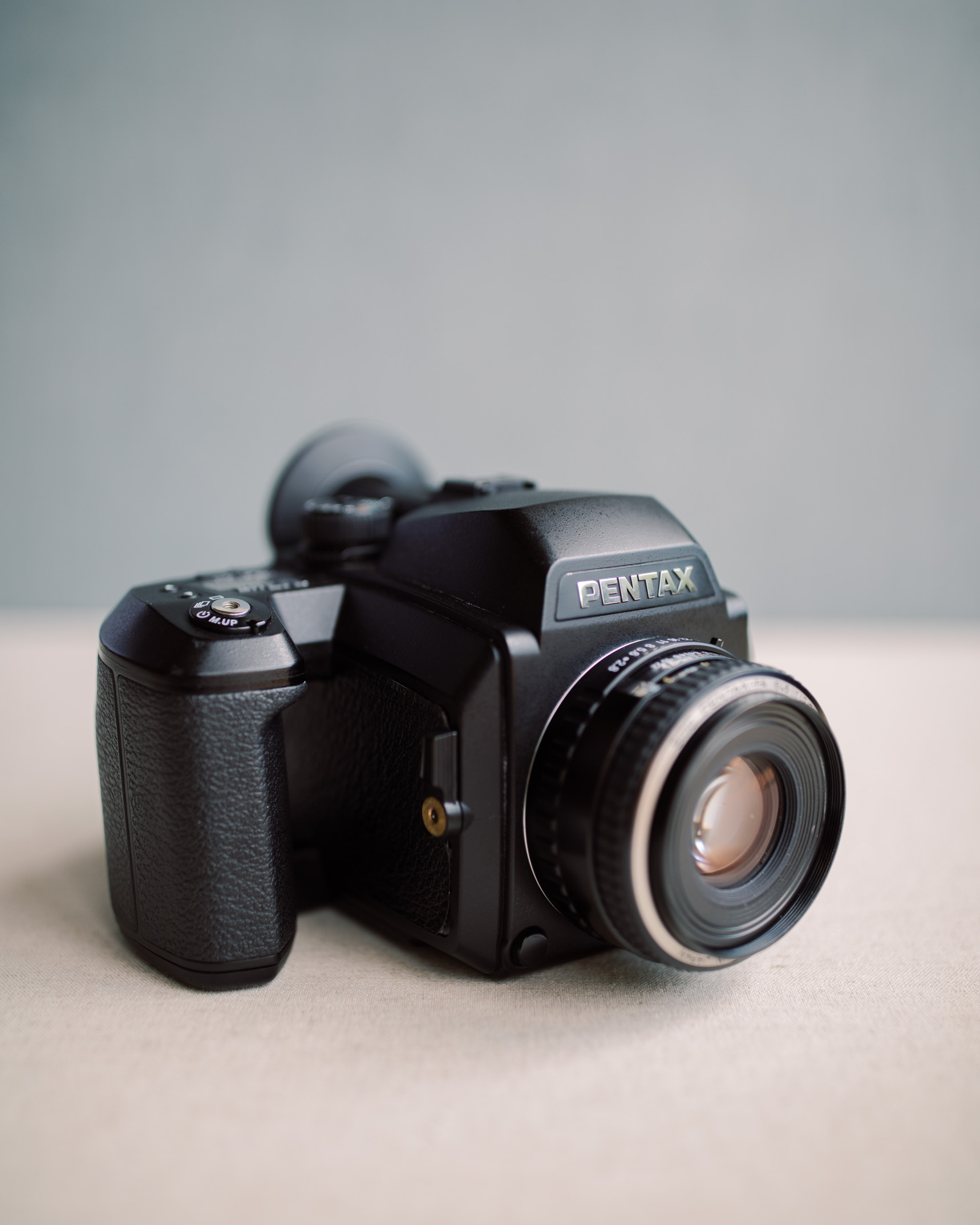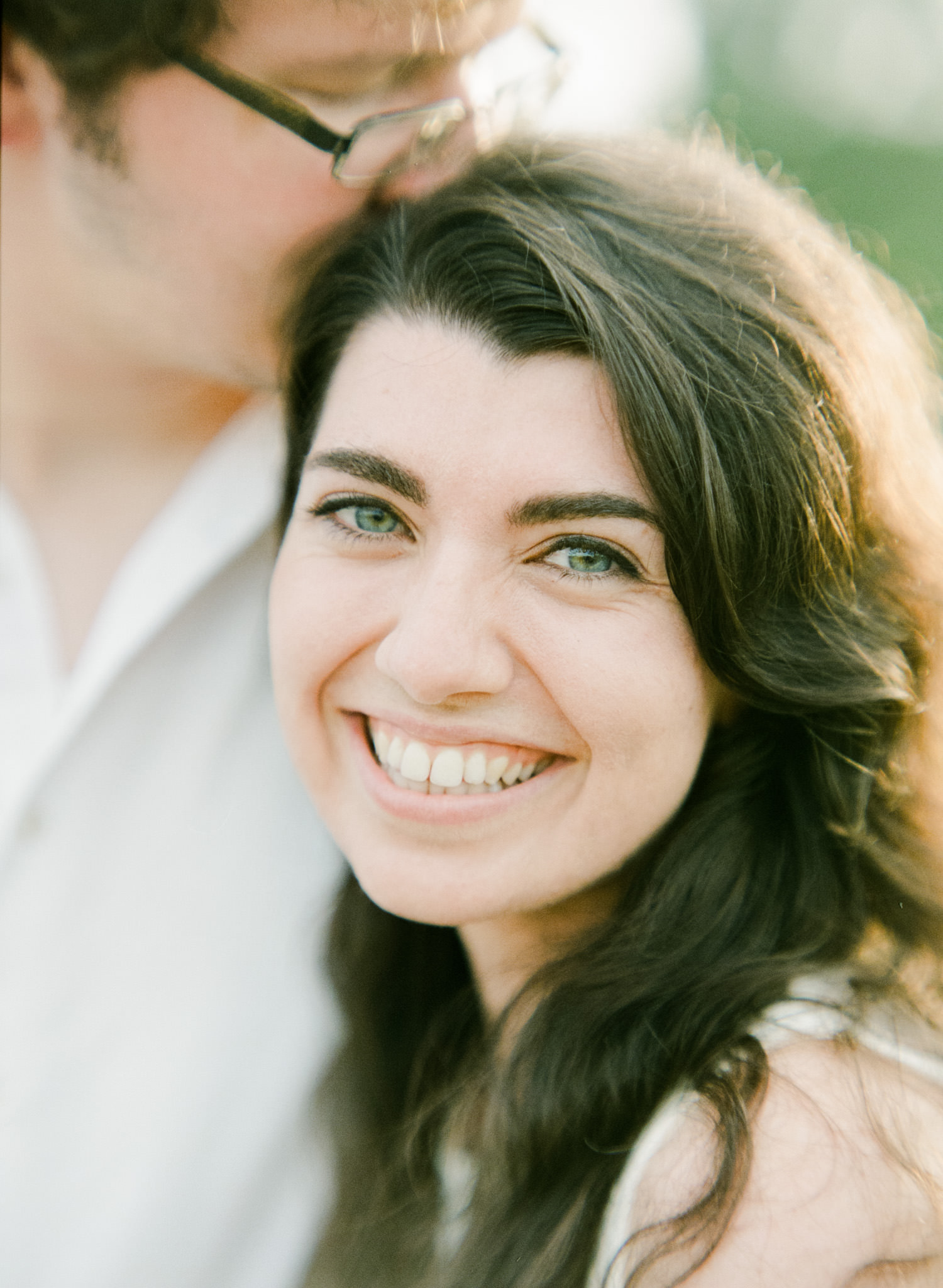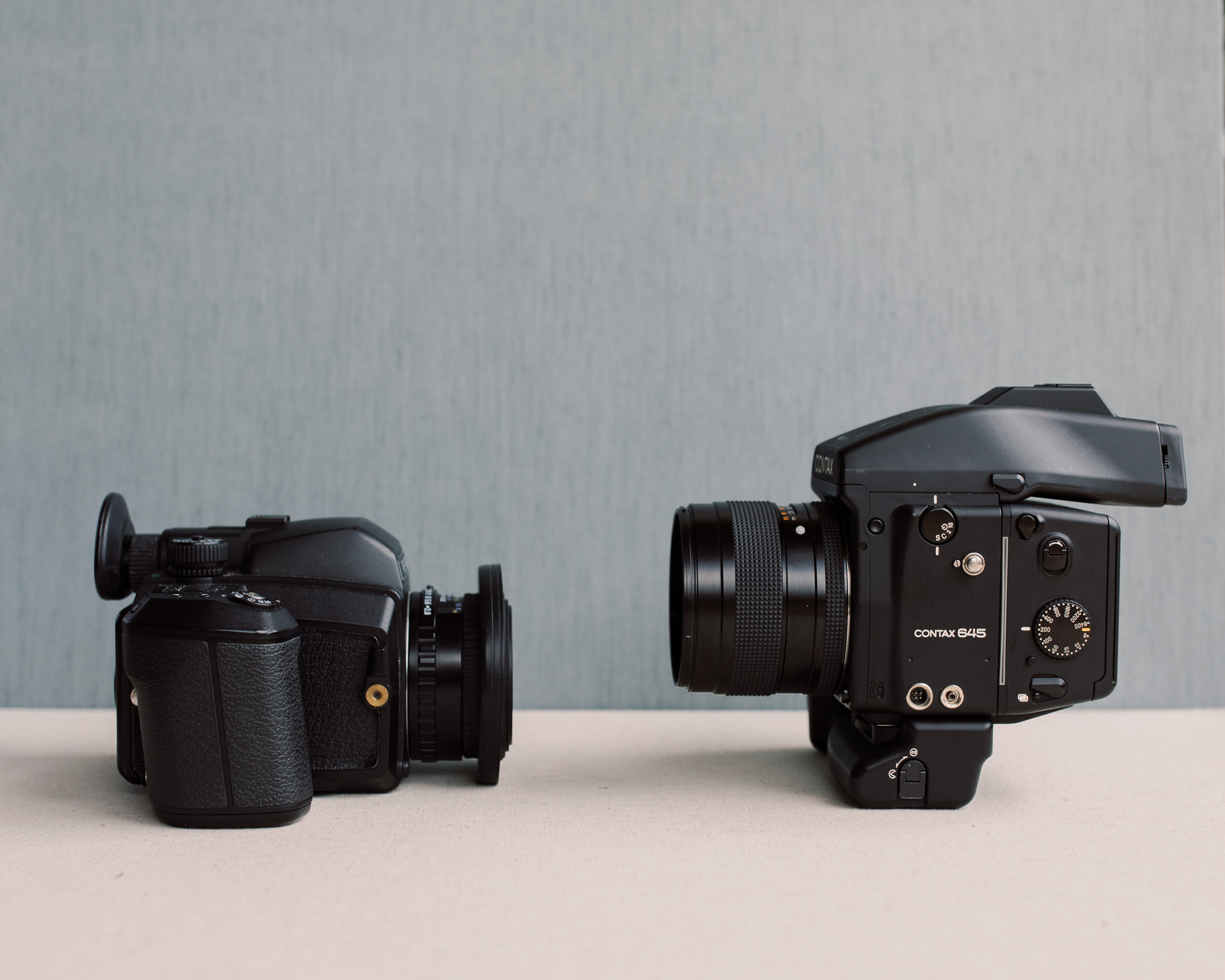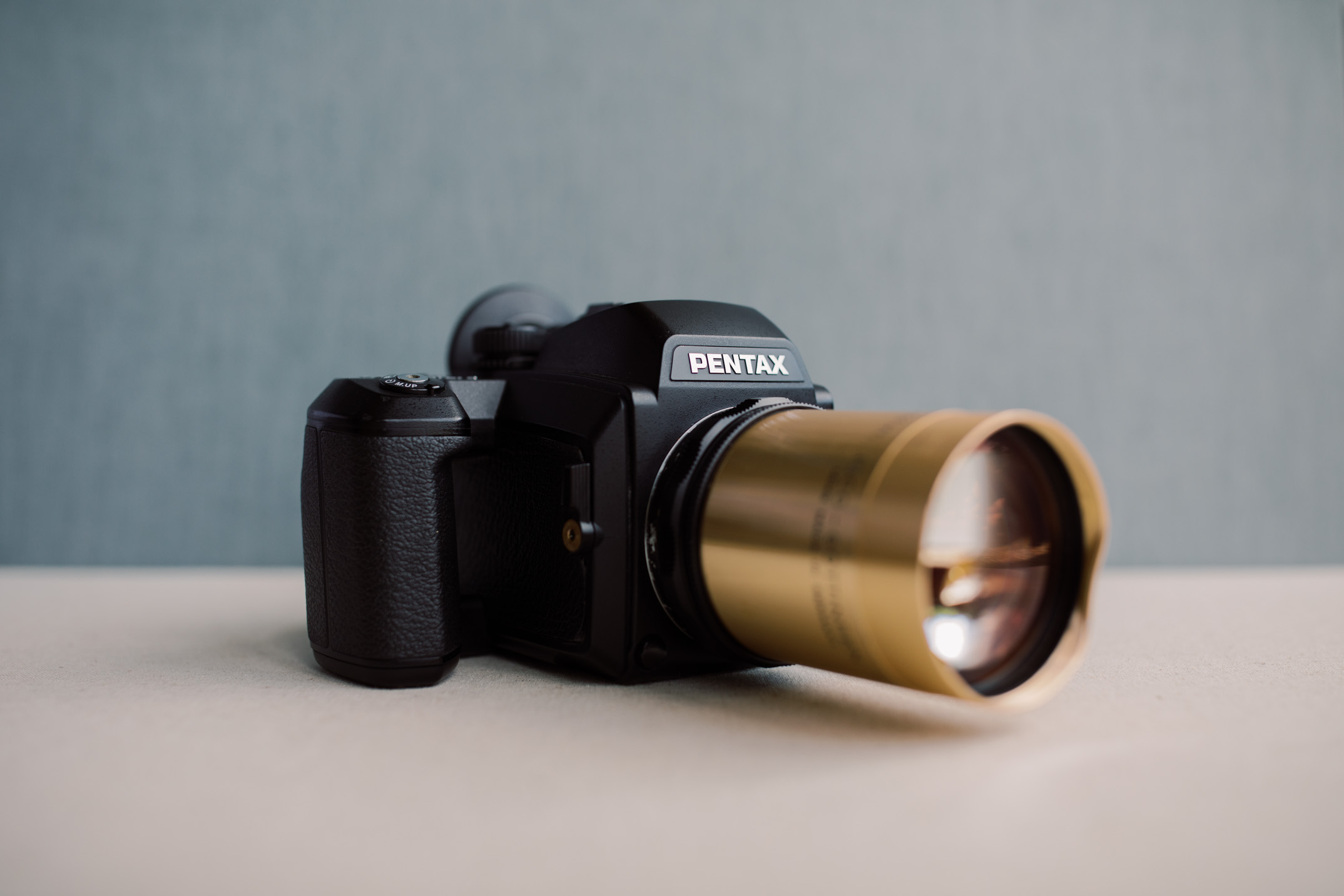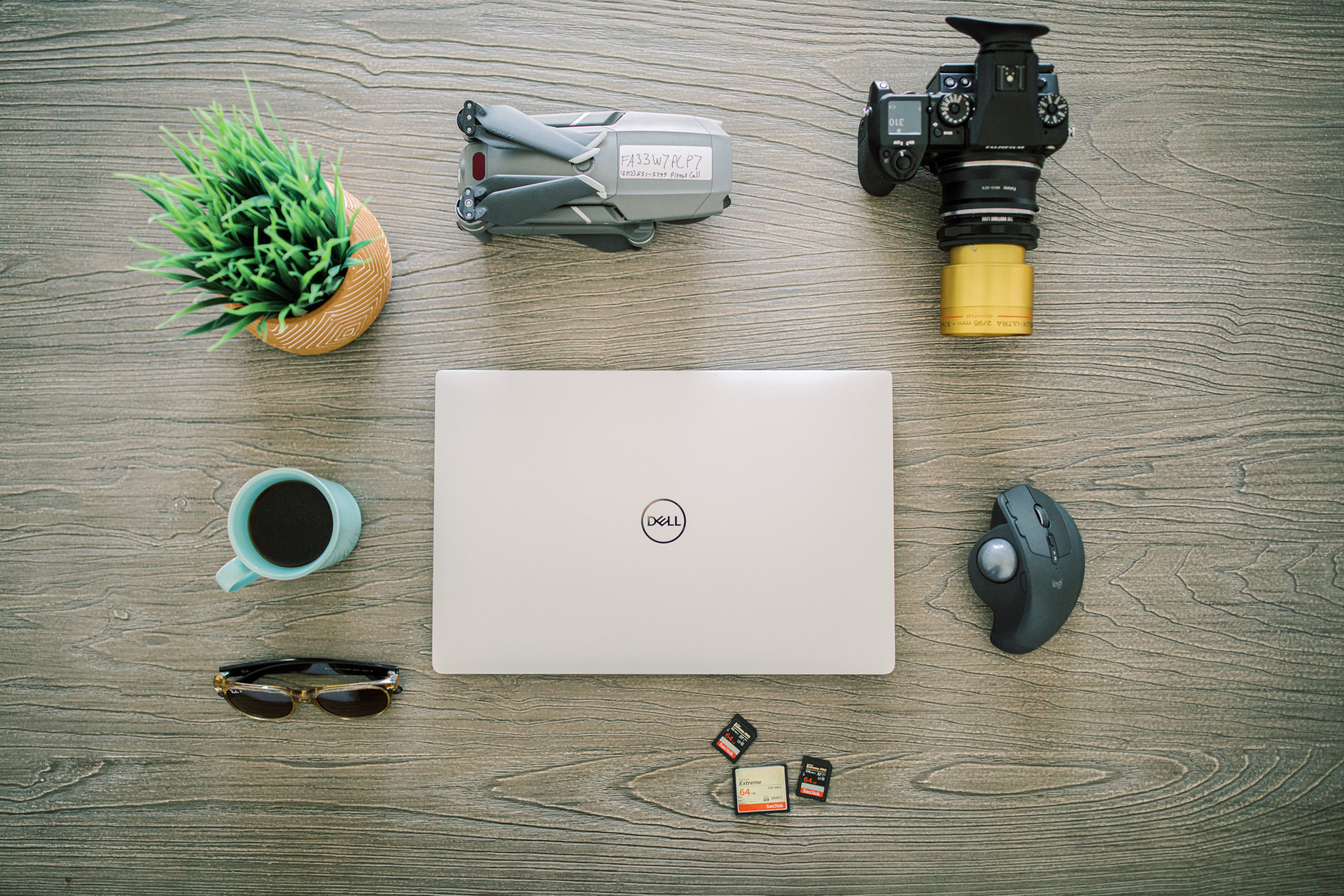Pentax 645nii with Schneider Cine-Xenon 120mm f/2 Projector Lens from The Boutique Lens
Note: This post is part of our "Learn Blog" for photographers. For workshops, coaching, and other resources designed to help grow your skills as a photographer click here (after you read the article, of course)! To be transparent, all links are paid advertising, as a portion of any purchase made while using these links is credited to us. Please, consider using our links to help support what we do! Thank you!
Ah, the Pentax 645—one of my all time favorite film cameras, and for good reason! It’s cheaper and generally more reliable than a Contax 645, though its native 75mm 2.8 doesn’t hold much of a candle against the bokeh and creaminess of the Zeiss 80mm f/2.
However, with the use of adapted Cinelux lenses, I have a new found love of the Pentax 645. More on those later in this post!
I’ve owned all three versions of the Pentax 645, and my current favorite is the Nii. I’ll discuss all three versions in this article, so this could be considered a Pentax 645 review, and Pentax 645n review, and a Pentax 645nii review, all in one.
So, let’s dive into my Pentax 645 review!
Pentax 645 vs Pentax 645n vs Pentax 645nii
Up front, let’s go ahead and get this out of the way—spec-wise, all versions of the Pentax 645 are almost identical. The major differences lies in that the Pentax 645 is manual focus only, while you can both manual and auto-focus (with autofocus lenses, of course) on the two newer versions (n and nii).
Differences between pentax 645 and newer versions
Other upgrades to the original 645 include a meter increased by 2 stops worth, an updated meter pattern, one extra frame on 120mm film (15 vs 16 frames), the ability to imprint data onto the film, exposure memory lock, less shutter speeds (but with the ability to use BULB mode), among a few others. The newer versions also are slightly lighter at 1280g vs 1320g (about 1.4 oz. difference). See a list here of differences in chart form!
differences between the Pentax 645n and nii
The main spec differences between the Pentax 645n and nii are that the nii included mirror lock up, which is nice if you’re trying to avoid any mirror shake while doing longer exposures.
Now, I will say, I’ve owned all three, yet my manual focus hit-rate has been the highest with the Pentax 645nii. This could have been due to other reasons other than just using the newest version, but I’ve also talking with someone else who had almost the same experience.
So, from now on, when I refer to the Pentax 645, it can be accounted for that I’m referring to any version.
What I Love About the Pentax 645 system
The Size of the Negatives: 645 vs 35mm
Anyone that has used a 35mm camera knows that you only get so much resolution with that size of a negative. So, enter in the beauty of a larger frame such as the 645 format. With an area that’s about 2.7 times the size of a 35mm frame, you get lots more resolution and less grain than you’ll get out of your 35mm while using the exact same film stock.
Price
The price of the Pentax 645 is definitely an attraction. Pentax 645s can range from $130 to $650 normally, with the lower end being the original 645 and the higher end being the newest 645nii and the 645n taking the middle price ground.
Ergonomics
The Pentax 645 feels great in hand. It’s easy to hold for just about any adult. The grip is robust and its a charm to operate. The only downside, in my book, is that you must change the shutter speed by using the dial. This obviously isn’t as fast as using a click wheel.
You’ll notice below that I mention that this is one area where the Hasselblad H1/H2 shines in comparison to the Pentax 645.
Ability to Use Lenses that Have Shallow Depth of Field
The native Pentax 645 75mm f/2.8 lens is equivalent to about a 42mm f/1.6 when compared to a full-frame/35mm film camera. That’s pretty shallow, but there are even more impressive options.
My personal favorite lens option is adapted Cinelux lenses which can enable you to reach f/2 and even f/1.7 for a very unique look.
Image taken with Pentax 645nii and Schneider Cine-Xenon 100mm f/2 lens from The Boutique Lens
One very popular option is the Pentax 67 105mm f/2.4, which can be easily adapted to the Pentax 645 using this adapter. There are a few versions of this lens, so be sure to check out our article on the Pentax 67 105mm f/2.4!
If you’d like a specific guide with links to get the 105mm 2.4 on your Pentax 645, we’ve also written a simple guide on adapting the Pentax 67 105mm to your Pentax 645.
Some Potential Problems with the Pentax 645 System
Focusing Issues
As I mentioned, I’ve owned all three versions of the Pentax 645 and had pretty major issues with the Pentax 645 (original) and the Pentax 645n. Now, that could have been from issues with the inserts or even with the mirrors in the cameras.
But, I will say, I am very very happy to now have highly accurate Pentax 645nii.
Backs vs Inserts
The Pentax 645 uses inserts as opposed to film backs. Film insert must have all frames completed before you can switch them out. Backs, on the other hand, can be removed mid-roll, allowing for the use of various film stocks without needing to finish the prior roll.
Due to my shooting style, I never need to change mid-roll, so this was a non-issue.
Pentax 645 Alternatives
There are a few great 645 cameras that have various strengths compared to the Pentax 645. I won’t go to far into detail, but the following list and discussion will give a good, brief overview! If you’d like a more comprehensive comparison of medium format cameras commonly used by wedding photographers, check out this post!
Contax 645 vs Pentax 645
The most popular alternative to the Pentax 645 is the Contax 645. The body itself feels more expensive. The Zeiss 80mm f/2 lens has way more character than the Pentax 645s 75mm f/2.8.
Contax 645 vs Pentax 645nii
However, the Contax 645 setup can be rather expensive ($3000USD and up) vs most expensive Pentax 645 kits costing around $1100USD. Contax 645s are known to be a bit more temperamental as well.
To learn more about our thoughts on the Contax 645, check out our Contax 645 review!
Mamiya 645 vs Pentax 645
Mamiya 645s and the various iterations over the years are very good options. The earlier versions supposedly have darker focus screens, making manual focus a bit more difficult.
The claim to fame lens for Mamiya 645 will be the manual focus 80mm f/1.9 lens, which is great, though arguably not as good as the Zeiss 80mm f/2 for the Contax 645.
All in all, the Mamiya 645 system, especially a later AF version, will be comparable to a Pentax 645 in many ways.
Hasselblad H1/H2 vs Pentax 645
Hasselblad H2 vs Pentax 645nii
H1 and H2 differ from the Pentax 645s in that their interface is much more digital. They have a lot of customization options in the menu compared to the Pentax 645.
The autofocus in arguably better than the Pentax 645n and nii. The H1 and H2 bodies are also known to be as reliable as Pentax 645s. The special lens for the H1 and H2 is the 100mm f/2.2 lens which is on par with the Zeiss 80mm f/2.
The biggest drawback to an H1 and H2 will be availability and price. With the 100mm f/2.2 lens, they will tend to run similar if not slightly cheaper than the Contax 645/80mm combo. The price can be quite a bit lower if only using the Hasselblad 80mm f/2.8 lens, which is also great, but not quite as magical, in my opinion.
Where to Buy Pentax 645s
Due to your ability to pick a reliable seller with a good return policy, and the buyer protection, I recommend purchasing your Pentax 645 from eBay . I’ve bought all three of mine from there and would do it again!
Pentax 645 Review Conclusion
All in all, the Pentax 645 is a very good medium format film camera option. It is quite possibly the best beginning medium format film camera due to its price-point, simple layout, and ease of use.
Let us know in comments below what your thoughts about the Pentax 645 are!



